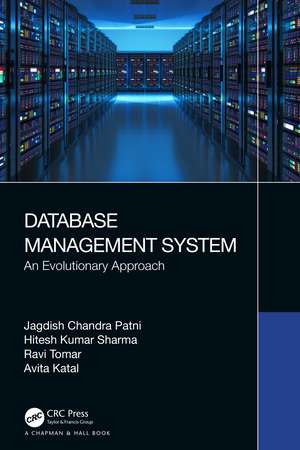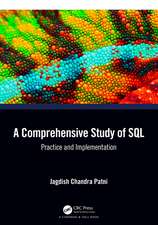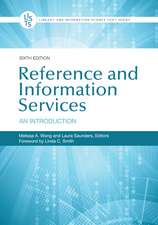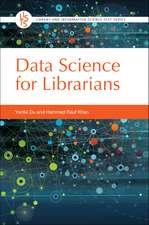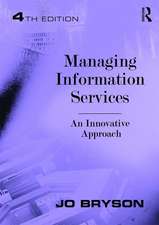Database Management System: An Evolutionary Approach
Autor Jagdish Chandra Patni, Hitesh Kumar Sharma, Ravi Tomar, Avita Katalen Limba Engleză Hardback – 27 ian 2022
The primary goal of a DBMS is to provide an environment that is both convenient and efficient to use in retrieving and storing database information. It is an interface between the user of application programs, on the one hand, and the database, on the other.
The objective of Database Management System: An Evolutionary Approach, is to enable the learner to
- grasp a basic understanding of a DBMS, its need, and its terminologies
- discern the difference between the traditional file-based systems and a DBMS
- code while learning to grasp theory in a practical way
- study provided examples and case studies for better comprehension
This book also gives detailed knowledge with a focus on entity-relationship (ER) diagrams and their reductions into tables, with sufficient SQL codes for a more practical understanding.
Preț: 763.51 lei
Preț vechi: 954.39 lei
-20% Nou
Puncte Express: 1145
Preț estimativ în valută:
146.11€ • 158.66$ • 122.74£
146.11€ • 158.66$ • 122.74£
Carte tipărită la comandă
Livrare economică 22 aprilie-06 mai
Preluare comenzi: 021 569.72.76
Specificații
ISBN-13: 9780367244934
ISBN-10: 0367244934
Pagini: 251
Ilustrații: 77 Tables, black and white; 47 Line drawings, black and white; 47 Illustrations, black and white
Dimensiuni: 156 x 234 x 16 mm
Greutate: 0.53 kg
Ediția:1
Editura: CRC Press
Colecția Chapman and Hall/CRC
ISBN-10: 0367244934
Pagini: 251
Ilustrații: 77 Tables, black and white; 47 Line drawings, black and white; 47 Illustrations, black and white
Dimensiuni: 156 x 234 x 16 mm
Greutate: 0.53 kg
Ediția:1
Editura: CRC Press
Colecția Chapman and Hall/CRC
Public țintă
AcademicCuprins
1. Basics of Database. 1.1 Introduction and History of Database. 1.2 Data and Information. 1.3 Database. 1.4 Need for a Database. 1.5 File based database management system. 1.6 Database System. 1.7 Database System components. 1.8 Database Management System Services. 1.9 Database Characteristics. 1.10 Advantages of Database. 1.11 Limitations of Database. Case Studies. Summary. Review Questions. References. 2. Data models and Architecture of DBMS. 2.1 Evolution of Data Model. 2.2 Hierarchical Database Model. 2.3 Network Data Model. 2.4 Relational Database Model. 2.5 Object Oriented Data Model. 2.6 Object Relational Data Model. 2.7 Three Level Architecture of Database. 2.8 Data Independence. 2.9 Database Languages. Summary. Review Questions. References. 3. Relational Database Management System (RDBMS). 3.1 Difference Between RDBMS and DBMS. 3.2 Features of RDBMS. 3.3 Advantages of RDBMS. 3.4 Disadvantages of RDBMS. 3.5 Examples of RDBMS. 3.6 RDBMS Terminologies. 3.7 Keys in Database. 3.8 Integrity Constraints in DBMS. 3.9 Relational Algebra. 3.10 Structured Query Language (SQL). 3.11 CODD’s Twelve Rules of Relational Database. 3.12 Database Development Life Cycle. Summary. Case Studies. Review Questions. References. 4. Entity Relationship Model. 4.1 Entity Relationship Diagram. 4.2 Components of a ER Diagram. 4.3 Participation Constraints. 4.4 Strong and Weak Relationship. 4.5 Handling Many to Many Relationship. 4.6 Example of E-R Model. 4.7 Enhanced Entity-Relationship Model. 4.8 Reduction of ER Diagram to Relational model. Summary. Review Questions. References. 5. Normalization. 5.1 Introduction Normalization –A bottom up approach. 5.2 Need for Normalization. 5.3 Types of Dependencies. 5.4 First Normal Form. 5.5 Second Normal Form. 5.6 Third Normal Form. 5.7 Boyce-Codd Normal Form. 5.8 Multi-valued Dependency. 5.9 Join Dependency. 5.10 Lossless and Lossy Decompositions. Summary. Review Questions. References. 6. Managing Data Using Structured Query Language (SQL). 6.1 Introduction to SQL. 6.2 Data Definition Commands. 6.3 Data Manipulation Language (DML). 6.4 Data Control Language. 6.5 Transaction Control Language (TCL). 6.6 Data Query Language (DQL). 6.7 Aggregate Functions. 6.8 Date and Time Functions. 6.9 String Functions. 6.10 Conversion Functions. 6.11 Mathematical Functions. 6.12 Special Operators. 6.13 Types of Constraints. 6.14 Sub Query. Summary. Review Question. References. 7. Introduction to PL/SQL. 7.1 Variable and Constants. 7.2 Data Types. 7.3 PL/SQL Literals. 7.4 Control Statement. 7.5 PL/SQL case statement. 7.6 PL/SQL Loop. 7.7 PL/SQL Continue statement. 7.8 PL/SQL GOTO statement. 7.9 PL/SQL Procedure and Functions. 7.10 PL/SQL cursor. 7.11 PL/SQL Exception. 7.12 PL/SQL Exception Handling. 7.13 PL/SQL Triggers. Summary. Review Questions. References. 8. Transaction Management in Database. 8.1 Definition of Transaction. 8.2 Properties of Transaction. 8.3 States of Transactions. 8.4 Schedule. 8.5 Serializability. 8.6 Recoverable Schedules. 8.7 Concurrency Control. 8.8 Concurrency Control Mechanism. 8.9 Database Back UP and Recovery. 8.10 Security, Integration and Authorization. Summary. Review Questions. References.
Notă biografică
Jagdish Chandra Patni, Hitesh Kumar Sharma, Ravi Tomar, Avita Katal
Descriere
This book explains the basic and advance concepts necessary for designing and implementing database systems and database applications. It puts emphasis on the core technical part of database modelling and design. It is meant to be used as a textbook for a technical course in database systems at the undergraduate and graduate level.
